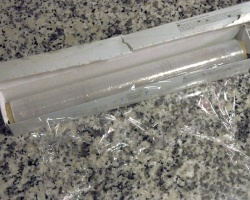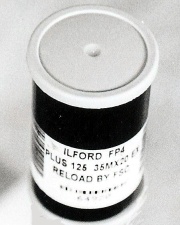How can I reuse or recycle … the least clingy cling film ever?
 A few years ago, I bought a box of supermarket value cling film (aka plastic wrap, saran wrap, cellophane) but in the process of making it value, the producers seem to have left out the cling.
A few years ago, I bought a box of supermarket value cling film (aka plastic wrap, saran wrap, cellophane) but in the process of making it value, the producers seem to have left out the cling.
I don’t use it much anyway (more of a fan of re-usable tubs) but whenever I do use it, it’s absolutely infuriating because it doesn’t stick to the bowl/pan in question, or to itself, thereby rendering itself utterly pointless as a thorough covering. Grrr.
So any suggestions on what I can use it – essentially just very thin plastic sheeting – for instead?
(Photo by Ilmari Karonen, c/o Wikipedia)























use it as a propagation sheeting in the shed (cut the lil holes, spead over soil, add a seed a hole),
use it to Re-cover old wooden handles on knives and the like (pop the knife in the oven with some grub to dry the wood out, then cover the handle with the plastic, and pop it under the grill for a few seconds… presto! water proofed and more hygenic!
stop ash and the like from dropping into your keyboard by taking the top off, then covering the underside of the keyboard with the sheeting and screw it back down.. bingo, a longer lasting, spill and dust proofed keyboard!
Put down a square of foil, a square sheet of plastic wrap, put a plant pot in the middle and gather up the foil and plastic – instant plant pot tray.
Use it to stop the skin from forming on puddings / soups / etc (apply the wrap directly on the top of the food to keep the moisture in)
Stretch the wrap into ropes and use as gentle ties for plants, etc.
I’m sure that you could crochet with it as well. Into what – that’s up to you.
Use rubber bands to secure the non-cling wrap over the things you wish it would cling to.
Paint pretty patterns on it using the recycled nail polish and use it to wrap presents, stuff in the top of gift bags, or top gift baskets.
I think i can help you understand why the cling-film u used doesn’t stick on to the container that u are using.
You have to consider that their are many different tyes of cling-film so it depends on the type of cling-film that you buy. PCV cling-film is a film that will stick onto all surfaces but if you buy non-PVC cling-film you’ll get the result u optained. so next time u buy cling-film make sure it’s on with PVC inside. And if your worried about polluting, don’t be because the PVC cling-film does not polute any more than non-PVC cling-film.
I hope u understand why your cling-film didn’t stick to your surfaces.
What you bought is actually a Linear Low Density Polyethylene type of “stretch” film – not cling film. The proper LLD cling film has a PIB – polyisobutylene “tackifier” to make it cling. PIB is added at extrusion time of manufacturing and it takes about 24 hrs to “cure” meaning that the PIB migrates to the surface of the film during this curing time. Voila – this is food safe non-toxic Polyethylene cling film.
On the other hand PVC or PVDC (Polyvinyl-di-chloride) cling film has nasty by-products released when heated in a microwave or otherwise e.g. chlorine. It typically smells of a new “shower curtain” and has a light brownish appearance – ever wrapped cheese with PVC cling film? Ughh!
Use LLD polyethylene cling film. Modern LLD polyethylene cling films can be manufactured with an Oxo-Biodegradable additive which typically degrades in about 18 months.
During the winter months we have used clingfilm as secondary glazing over our singly-glazed front door and a couple of windows. It takes some practise to get it done neatly, Use double sides sticky tape to stick a sheet of it on the wall or window frame about a centimetre or two from the glass, so it forms an air pocket, make sure it’s all sealed and the air pocket is all trapped, and put a hairdryer on it to smooth it out and make it go taut. It really makes a difference to the amount of heat lost and energy wasted, so it’s all good :)